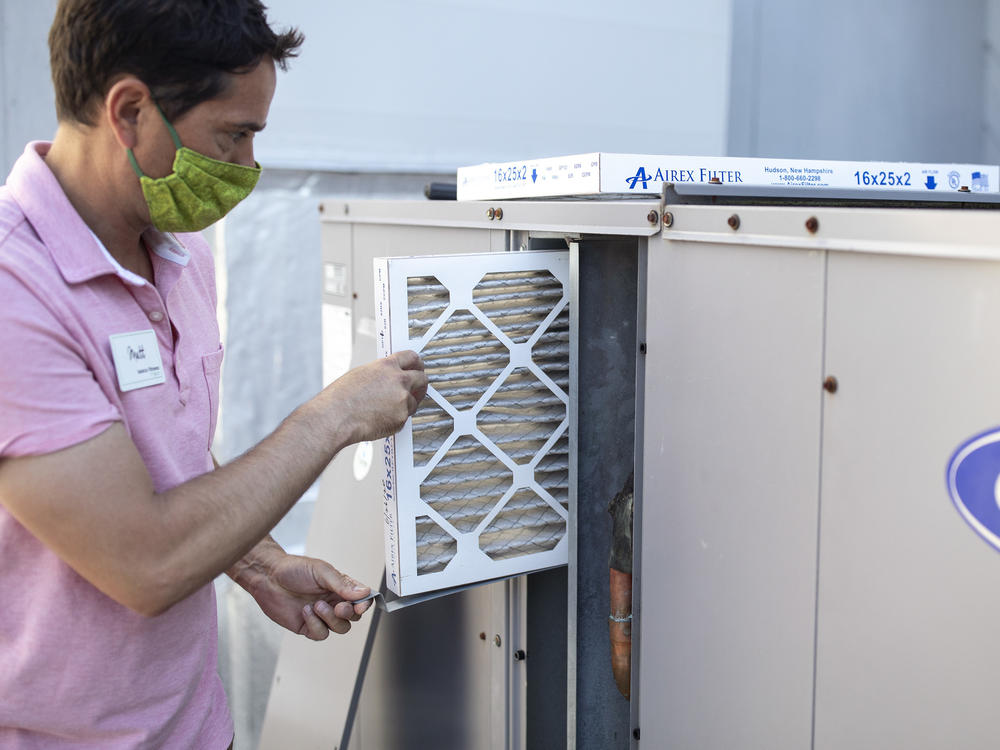Section Branding
Header Content
As We Return To Work And School During The Pandemic, Can The Air Inside Be Kept Safe?
Primary Content
Across America, buildings are opening back up — offices, schools, theaters, stores, restaurants — even as evidence mounts that the coronavirus can circulate through the air in a closed indoor space.
That means a lot of business owners and facility managers are calling up people like Dennis Knight, the founder of Whole Buildings Systems in Charleston, S.C., asking what they can do to make sure their building doesn't spread the virus.
Knight has some disappointing news.
"You cannot guarantee that someone might not get sick," he says.
But there are ways to reduce the risk. Knight is on the epidemic task force of ASHRAE, the organization of heating, ventilation and air conditioning professionals, which has assembled guidance for building operators on how to do exactly that.
But Knight warns building managers to be cautious of anyone selling them an air-purifying device or super-strong filter with an absolute guarantee that it will stop the virus.
"That's when the hairs stand up on the back of my neck, and I get really suspicious that ... I'm being approached by a snake oil salesman," he says. "Really, you've got to do everything. And you've got to do it with diligence. And even then, there's no guarantee."
"Everything" means covering the basics — making sure a building's HVAC system is up to code and correctly maintained. It means buying more efficient air filters (but not too efficient for your system; many HVAC systems can't handle the most effective filters). It means pulling more fresh outdoor air into the system. It means running the system for more hours in the day, including flushing cycles before or after people are inside. It means considering portable units with HEPA filters or UV lights to sanitize air.
And it could mean opening windows and doors — or if there's one room with really poor ventilation, maybe not using that room at all.
There's a lot to consider. And as the science on COVID-19 has been evolving, the right actions haven't always been clear. Now, some building operators are intimidated or overwhelmed by the scale of the challenge.
"It's tricky and it's confusing and in large part, it's scary," says Kathleen Owen, an air filtration consultant in Cary, N.C., who also works with ASHRAE.
"And the answer to it is, first, don't panic. Second, do what you can," she says.
Owen compares it to face masks. An N95 is ideal, but not available for everyone. A cloth mask is less effective, but much better than nothing.
Similarly, if a building's HVAC system can't handle an extremely efficient filter like a HEPA or a MERV 13, then install the best filter that the system can handle. And don't forget all the other ways to reduce the risk, such as running the system longer or pulling in more fresh air.
Raj Setty, an engineer in Washington, D.C., has been advising schools and businesses on how to reopen safely. He says he really wants to see more institutions thinking creatively about ventilation. Like, can schools set up tents in their fields? Can they rearrange schedules to take breaks in the winter, and hold classes in the summer, if that makes outdoor classes more feasible?
"Maybe you go virtual when it's over 90 degrees and then when it's under 90 degrees, you just hold class outside," he says.
When going indoors is unavoidable, Setty's company has designed a spreadsheet engineers and others can use to help think through the different options for improving air quality and reducing risk, from investing in ultraviolet disinfection to simply reducing the number of people indoors.
Setty acknowledges there's no way to get the risk down to zero and that scientists are still working to understand the virus. But while science continues to carry out research, he says, it's up to engineers to apply what we know.
When people have to gather inside a building, Setty says there's no real downside to bringing in fewer people, better air filters and more fresh air.
It might cost more money, but better air quality is a boost to human health — and not just during a pandemic.
Copyright 2020 NPR. To see more, visit https://www.npr.org.

